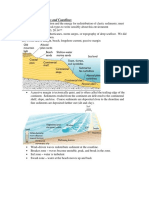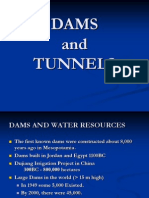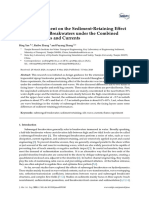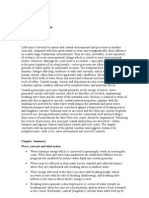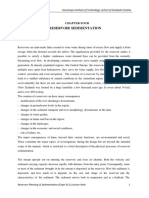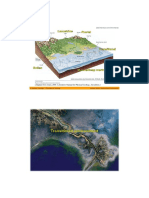0 ratings0% found this document useful (0 votes)
89 views1.6. Sediment Transport and Dredging
Sediment transport must be carefully considered when planning ports. Waves play a key role in transporting sediment near coastal areas. Sediment accumulation can be a serious problem for harbor basins due to still waters allowing sediment to settle. Dredging is often needed to maintain navigation channels and harbor basin depths using mechanical or hydraulic methods. The economics of dredging are influenced more by fixed capital costs than variable operating costs.
Uploaded by
Melvin EsguerraCopyright
© © All Rights Reserved
Available Formats
Download as DOCX, PDF, TXT or read online on Scribd
0 ratings0% found this document useful (0 votes)
89 views1.6. Sediment Transport and Dredging
Sediment transport must be carefully considered when planning ports. Waves play a key role in transporting sediment near coastal areas. Sediment accumulation can be a serious problem for harbor basins due to still waters allowing sediment to settle. Dredging is often needed to maintain navigation channels and harbor basin depths using mechanical or hydraulic methods. The economics of dredging are influenced more by fixed capital costs than variable operating costs.
Uploaded by
Melvin EsguerraCopyright
© © All Rights Reserved
Available Formats
Download as DOCX, PDF, TXT or read online on Scribd
You are on page 1/ 1
1.6.
Sediment transport and dredging
Planning of a port in regions with significant sediment transport requires special care. Many
ports have failed or led to unexpected high maintenance costs because of inadequate
treatment of sediment transport.
Two kinds of sediment transport caused by currents and waves
1. Bed load
- Sediment is transported in the form of rolling along sea bed.
2. Suspended load
- Sediment is suspended by the turbulence due to wave breaking and transported.
Waves play a decisive role in coastal sediment transport process. The sediment transport
capacity increases as the water gets shallow, and in the breaking zone, high concentration of
suspended sediment occur. In the case where the tidal current is superimposed on the wave
action, the sediment transport capacity is much higher than the current along, because the
orbital wave motion at the bed generates a high concentration of sediment near the bed,
which in turn is transported by the current. This mechanism is important in connection
with dredged channels.
Sediment accumulation in the harbour basin can be a serious problem because the still water
in the basin provides an ideal condition for the suspended sediment passing through the
entrance to settle down.
Dredging is often necessary in order to maintain the water depth in navigation channels and
harbour basins.
Method of dredging
1. Mechanical
- Sediment is picked up on board by a bucket moved by a very strong arm and
boom. The sediment is then transported and dumped in another place.
2. Hydraulic
- It is the most popular and economical method. Sediment is sucked from the sea bed
and then discharged through pipes to a spoil disposal area (land or sea).
With respect to dredging economics, the variable costs, such as labor, fuel are minor
compared with the fixed costs arising from new equipments, which are often manufactured
specifically for the project. Moreover, the dredging efficiency is greatly influenced by the
weather.
You might also like
- Planning and Layout of Ports and HarborsNo ratings yetPlanning and Layout of Ports and Harbors1 page
- CE-580-Lecture 9 - Aug 11 - 2022 - SedimentationNo ratings yetCE-580-Lecture 9 - Aug 11 - 2022 - Sedimentation29 pages
- Detailed Notes - Coastal Systems and Landscapes - AQA Geography A-levelNo ratings yetDetailed Notes - Coastal Systems and Landscapes - AQA Geography A-level28 pages
- Water Resources - National and International: Single Purpose ReservoirsNo ratings yetWater Resources - National and International: Single Purpose Reservoirs167 pages
- General Design and Location Features: EctionNo ratings yetGeneral Design and Location Features: Ection2 pages
- ACI 347.2R-05 Guide For Shoring-Reshoring of Concrete Multistory Buildings - MyCivil - Ir100% (1)ACI 347.2R-05 Guide For Shoring-Reshoring of Concrete Multistory Buildings - MyCivil - Ir21 pages
- 2016 Floodplain Reconnection and Channel Incision ReversalNo ratings yet2016 Floodplain Reconnection and Channel Incision Reversal28 pages
- Ballast Water Treatment Methods: Fact Sheet 7No ratings yetBallast Water Treatment Methods: Fact Sheet 72 pages
- Marine Wastewater Outfalls and Treatment Systems - Cap 8No ratings yetMarine Wastewater Outfalls and Treatment Systems - Cap 830 pages
- Floating Architecture - Very Large Floating Strucures (VLFS) : AbstractNo ratings yetFloating Architecture - Very Large Floating Strucures (VLFS) : Abstract2 pages
- River Training and Flood Control: Chapter FiveNo ratings yetRiver Training and Flood Control: Chapter Five26 pages
- Unit-5-5-Soil & Water Conservation Engg. - Lesson 22 Reservoir SedimentationNo ratings yetUnit-5-5-Soil & Water Conservation Engg. - Lesson 22 Reservoir Sedimentation7 pages
- Lecture 7 - Floods Prevention - 12.12.2024No ratings yetLecture 7 - Floods Prevention - 12.12.20244 pages
- Flume Experiment On The Sediment-Retaining Effect PDFNo ratings yetFlume Experiment On The Sediment-Retaining Effect PDF15 pages
- Check Your Understanding Answers: Option A Freshwater - Drainage BasinsNo ratings yetCheck Your Understanding Answers: Option A Freshwater - Drainage Basins42 pages
- XIV.-Judging Criteria and Scoring: Element Objective Scoring WeightNo ratings yetXIV.-Judging Criteria and Scoring: Element Objective Scoring Weight9 pages
- The Integration Process: D FX FX DX D DXNo ratings yetThe Integration Process: D FX FX DX D DX2 pages
- Integral Calculus Course Outline Prelim I. The Integration ProcessNo ratings yetIntegral Calculus Course Outline Prelim I. The Integration Process1 page
- Design of Isolated Footings of Rectangular From Using A New ModelNo ratings yetDesign of Isolated Footings of Rectangular From Using A New Model21 pages
- Prelim Quiz!: Analyze The Frames Shown Below. Show Your Complete SolutionNo ratings yetPrelim Quiz!: Analyze The Frames Shown Below. Show Your Complete Solution2 pages
- How Do I Create A New Duplicate Window in Excel?No ratings yetHow Do I Create A New Duplicate Window in Excel?3 pages
- Analysis of Isolated Footing Subjected To AF and High BM-ICJ-June 2014No ratings yetAnalysis of Isolated Footing Subjected To AF and High BM-ICJ-June 201421 pages
- Calculate Earthquake Forces On Buildings and StructuresNo ratings yetCalculate Earthquake Forces On Buildings and Structures5 pages
- An Example Problem On Wind Load Calculation According To NSCP 201089% (9)An Example Problem On Wind Load Calculation According To NSCP 201032 pages
- 0922 0923 0925 0932 0933 0942 New Prefix No. 0943 New Prefix No. NEXTEL Numbers 0979 - NEXTEL 0978 - NEXTELNo ratings yet0922 0923 0925 0932 0933 0942 New Prefix No. 0943 New Prefix No. NEXTEL Numbers 0979 - NEXTEL 0978 - NEXTEL1 page
- Architectural Engineering Technical Design Buildings Architect Structural Engineer Interior Designers ContractorsNo ratings yetArchitectural Engineering Technical Design Buildings Architect Structural Engineer Interior Designers Contractors1 page
- How Do I View Multiple Excel Workbook Sheets Side by SideNo ratings yetHow Do I View Multiple Excel Workbook Sheets Side by Side1 page






























